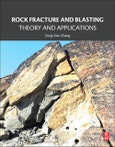Rock Fracture and Blasting: Theory and Applications provides the latest on stress waves, shock waves, and rock fracture, all necessary components that must be critically analyzed to maximize results in rock blasting. The positioning of charges and their capacity and sequencing are covered in this book, and must be carefully modeled to minimize impact in the surrounding environment.
Through an explanation of these topics, author Professor Zhang's experience in the field, and his theoretical knowledge, users will find a thorough guide that is not only up-to-date, but complete with a unique perspective on the field.
Please Note: This is an On Demand product, delivery may take up to 11 working days after payment has been received.
Table of Contents
1. Introduction
Part I-Stress Waves and Shock Waves
2. Stress Waves
3. Shock waves
4. Fracture and Fragmentation
5. Loading Rate Effects
6. Effects of Temperature
7. Effects of Environment (Confining pressure, Water and Cycling loading)
8 Rock drilling
9. Explosives and Initiators
10. Detonation Theory
11. Single-hole blasting-experimental investigation
12. Free Surface and Expansion Space
13. Burden, Spacing and Specific Charge
14. Stemming and Charge Length
15. Air deck, Decoupling Charge, Pre-split and Smooth Blasting
16. Primer placement
17. Delay times
18. Blasting in open cut and drifting
19. Blasting in Open-pit Mining and Quarries
20. Rock Blasting in Underground Mining
21. Numerical simulation of rock blasting
22. Optimum fragmentation in mining engineering
23. Blasting and Mining Economy
24. Impact of rock blasting on mining safety
25. Reduction of ground vibrations








